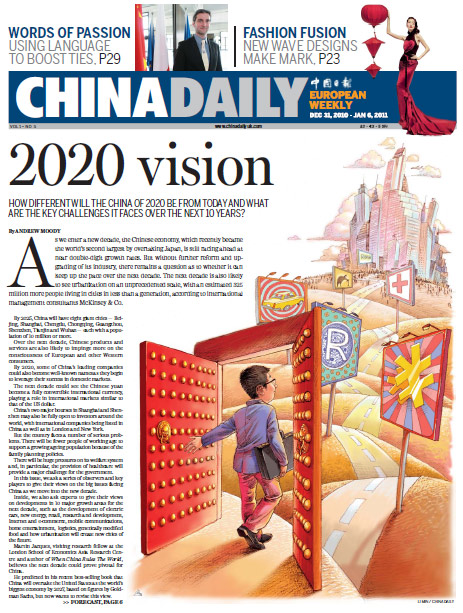European banks back on track for Chinese growth
Updated: 2010-12-17 10:19
By Horst Loechel (China Daily European Weekly)
As China becomes more international, European lenders are also working hard to be a part of growth story
European banks have a long tradition of doing business in China, a tradition that continues today with about 40 of these financial institutions operating here. These include the two largest foreign banks, HSBC and Standard Chartered.
European banks operating in China cover the entire spectrum of institutional structures. These include representative offices, branches, as well as full-fledged incorporation and stakes in domestic financial institutions. Locally incorporated banks include well-known names such as ABN AMRO, Calyon Bank, BNP Paribas, Deutsche Bank, HSBC, Societe Generale and Standard Chartered. The business model used very much depends on the scale and legal form of operation.
For example, locally incorporated banks provide the entire range of commercial and investment banking services for domestic, foreign private and corporate clients. Meanwhile, banks with branches only concentrate their business, in most cases, on corporate clients from their home markets; and representative offices can only counsel their clients on their China business.
In terms of assets, European banks account for about 40 percent of the market share of all foreign banks in China. That being said, the market share of all foreign banks in China is still low, making up only about 2 percent of overall assets. However, the larger European banks have a strong global network, which helps Chinese companies expand their business worldwide, for example, in Africa and Latin America. Most important are the numerous trade finance services that they offer, particularly between European and Chinese companies.
It is worth noting, also, that there is a new trend among European banks in China: The opening of new branches in the western region. This is in keeping with the overall "go west" thrust of China's economy. The new branches are not only set up in the larger cities, such as Chongqing, Chengdu and Xi'an, but also cover rural areas. In fact, some European banks offer rural finance services in the Inner Mongolia autonomous region and Hubei province that fund not only farmers but also small enterprises.
As China becomes more and more international and Chinese companies branch out globally, European banks are working hard to become a part of this growth as well. Special emphasis is being placed on the introduction of the yuan as an international trade settlement currency, which lays the foundation for a wide range of international transaction banking.
Another important development is the extension of China's capital markets, especially the corporate bond market. Because of their competitive advantage in this area, this is seen as a great opportunity for European banks to extend their businesses. In terms of ordinary deposits and credit, domestic institutions remain far ahead of the curve, given their extensive branch networks and the still-limited opportunities for competition with regards to price and product range.
The challenges for European banks - and for all foreign banks in general - are first, the refinancing of their yuan business due, in many cases, to a lack of sufficient deposits and second, staffing. There is indeed a fierce "battle for talents" within China's entire finance sector because of the combination of the industry's strong growth and the shortage of qualified employees. This dilemma has been leveraged, in recent years, with more and more offshore business moving onshore. This, in turn, has impacted costs since it almost always leads to an increase in spending on human resources.
However, after a difficult year in 2009 because of the financial crisis, European banks are back on track in China. For example, European banks in China are expecting about a 25 percent growth in revenues this year, on average. In the years ahead, new business opportunities are expected, particularly in the futures and corporate bond market, internationalization of Chinese companies and currency, as well as commodity finance. Furthermore, the foreseeable deregulation of the interest and exchange rate markets will create new business opportunities and possibilities for competition as well.
Of special importance is the intended development of Shanghai into an international financial center by 2020, as the central government announced last year. The accompanying changes will open the doors for new business opportunities and the chance for foreign companies to be listed on the Shanghai stock exchange. It would not be a surprise if a leading European bank in China is the first mover in this regard.
The author is director, German Center of Banking and Finance at CEIBS, Shanghai; and professor of economics at Frankfurt School of Finance & Management, Germany.

Paper's Digest

Convertible yuan
The yuan is likely to be fully convertible and on the way to being one of the world's major currencies by 2020.
Fight against inflation
Words of passion
Euro vision
Specials

Internet aids luxury sales
More sophisticated Chinese consumers are surfing for luxury products on the Internet and a number of branded labels are ready to ride the wave.

Tobacco controls
An anti-smoking watchdog has criticized Chinese authorities for "making little progress" on enforcing tobacco controls.

Godfather of yachts
Traugott Kaminski claims he was the first person to bring the yacht culture to China seven years ago.
